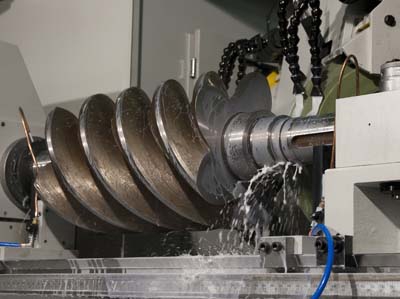
The Hardinge Grinding Group introduces a new 2-meter capacity, UltraGrind 2000 grinding machine manufactured by Jones & Shipman, a Kellenberger Company, which is a subsidiary of Hardinge Inc.
The machine design is based on Jones & Shipman's rugged, smaller capacity model, but features a new wheelhead design to provide customers a wide choice of external and internal grinding spindle combinations, effectively creating a custom machine, but without the cost and build time associated with it. The wheelhead offers wheel sizes up to 500 in diameter x 100mm and wheel spindle power up to 11kW.
"The ongoing need for high geometric accuracy with quick changeovers on cylindrical grinding machines was a key factor in the development of the robust Jones & Shipman UltraGrind series," states Jeff Hilliard, Grinding Sales Manager, Hardinge Inc.
The UltraGrind was designed with manufacturers of precision components in-mind; companies that have to produce complex precision parts, particularly in small-to-medium size volumes, and need maximum flexibility. Flexibility combined with ease-of-use improves productivity, keeping component prices competitive and matching some high-volume production systems that rely on using multiple machines.
Contact Details
Related Glossary Terms
- cylindrical grinding
cylindrical grinding
Grinding operation in which the workpiece is rotated around a fixed axis while the grinding wheel is fed into the outside surface in controlled relation to the axis of rotation. The workpiece is usually cylindrical, but it may be tapered or curvilinear in profile. See centerless grinding; grinding.
- grinding
grinding
Machining operation in which material is removed from the workpiece by a powered abrasive wheel, stone, belt, paste, sheet, compound, slurry, etc. Takes various forms: surface grinding (creates flat and/or squared surfaces); cylindrical grinding (for external cylindrical and tapered shapes, fillets, undercuts, etc.); centerless grinding; chamfering; thread and form grinding; tool and cutter grinding; offhand grinding; lapping and polishing (grinding with extremely fine grits to create ultrasmooth surfaces); honing; and disc grinding.
- grinding machine
grinding machine
Powers a grinding wheel or other abrasive tool for the purpose of removing metal and finishing workpieces to close tolerances. Provides smooth, square, parallel and accurate workpiece surfaces. When ultrasmooth surfaces and finishes on the order of microns are required, lapping and honing machines (precision grinders that run abrasives with extremely fine, uniform grits) are used. In its “finishing” role, the grinder is perhaps the most widely used machine tool. Various styles are available: bench and pedestal grinders for sharpening lathe bits and drills; surface grinders for producing square, parallel, smooth and accurate parts; cylindrical and centerless grinders; center-hole grinders; form grinders; facemill and endmill grinders; gear-cutting grinders; jig grinders; abrasive belt (backstand, swing-frame, belt-roll) grinders; tool and cutter grinders for sharpening and resharpening cutting tools; carbide grinders; hand-held die grinders; and abrasive cutoff saws.







